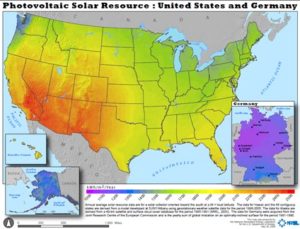Snow problem is no problem for solar in Minnesota


Despite our cold and snowy winters, Minnesota is a great state for solar electricity. In fact, our solar resource potential is better than of solar leader Germany, and as good as Houston, Texas.
“Northern Minnesota is at the same latitude as the southernmost part of Germany,” said Ellen Taube a Virginia, Minnesota solar homeowner. “Renewable energy sources including solar accounted for nearly one-third of the electricity consumed in Germany in 2015.”
Minnesota’s cold winter temperatures can improve the efficiency of the solar panels. In Arizona, solar homeowners have the reverse problem. The extreme heat of the summers causes the panels to work less efficiently in the midday sun.
To be sure, any snow that falls on the panels will block the sunlight. This inhibits their ability to produce electricity. If your panels are angled, they will generally shed the snow after a few hours or days, depending on how much snow and sunlight there is. Once a small corner is clear, the panel will start to warm in the sun, and the rest of the snow will slide off. What’s more, snow on the ground can reflect sunlight to the panels. This improves their output.
“I did not anticipate that on a sunny day after a snowfall, I would obsessively refresh the monitoring software from my desk at work to watch for the snow to slide off the panels and my production to spike back up,” said Laura Hannah a Minneapolis solar homeowner. “It’s gripping.”
You can clear snow off panels that are mounted on the ground by using a soft brush, such as those designed to clear snow off cars. You want to be sure not to scratch the panels. We do not recommend people clear snow off roof-mounted panels, though.
If you are thinking about going solar, your installer should be able to provide you an estimate of your annual solar production. This estimate should factor in snowy, cloudy, and/or rainy days we have. There are several tools that let you make an estimate yourself. The National Renewable Energy Laboratory has developed an estimator called PV Watts. The University of Minnesota has developed the Minnesota Solar Suitability Analysis App. Both tools account for variables such as your location, weather, system size, and roof angle to determine how much electricity your system should produce during its lifetime.
